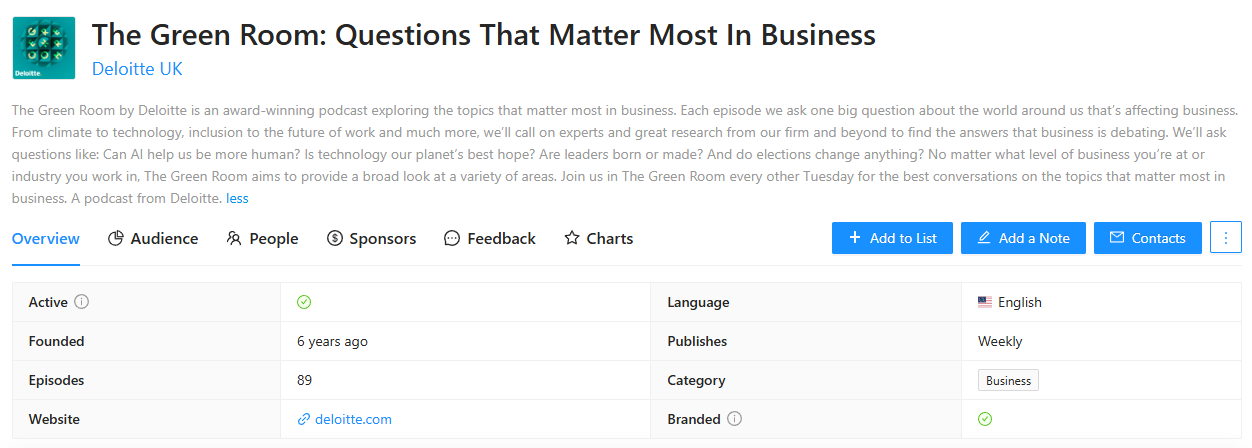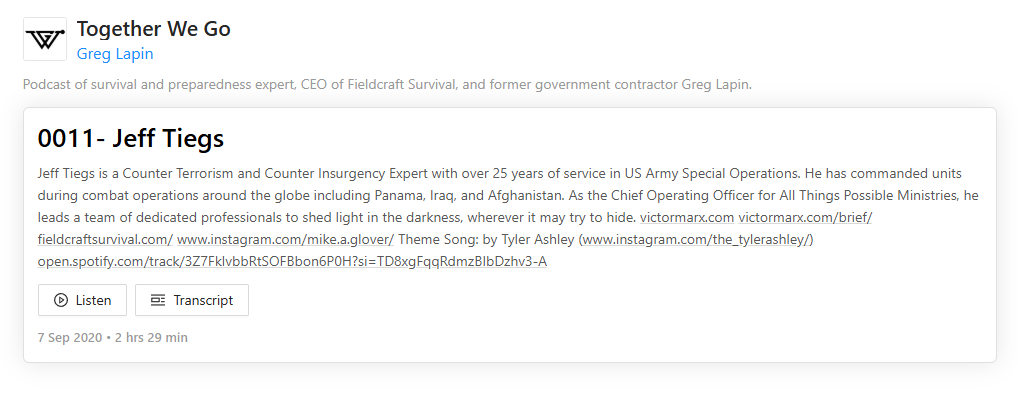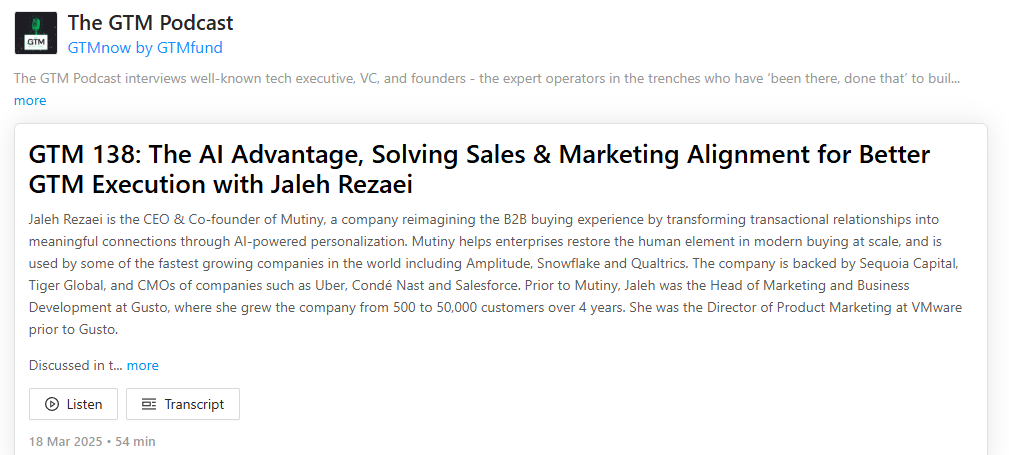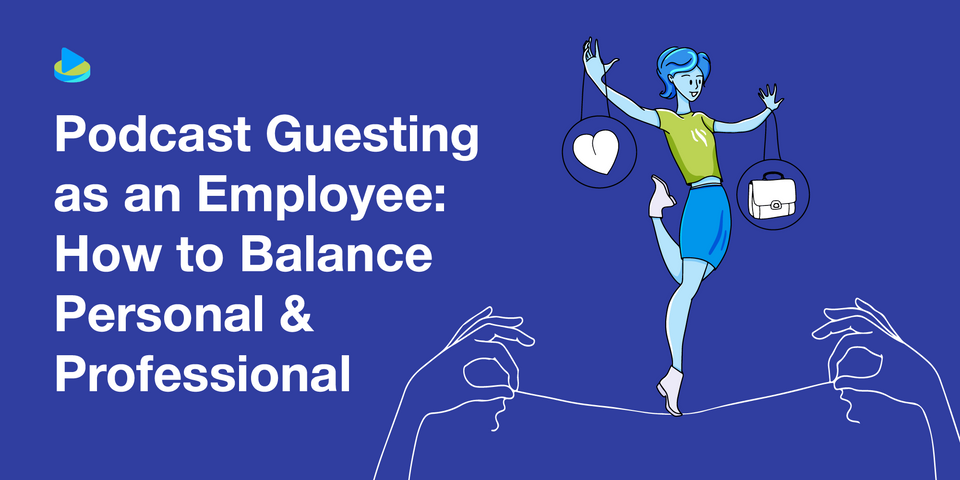The company you work for has decided to start podcast guesting—and you're the one chosen to represent the brand.
So, now you're faced with a core challenge. How do you balance personal authenticity with corporate representation? In other words, how do you show your personality while making sure you still showcase the company culture or journey?
At the two opposing ends of the spectrum we have:
- A very personal account—showing vulnerability, but straying from the brand story
- A sales pitch—making your interview all about the brand and product
Neither extreme is ideal.
First up, you want to avoid delivering a sales pitch at all costs, no matter what your CEO might say. Why? It's the number one way to turn off listeners. People listen to their favorite shows for great content, not a hard-sell. They want to be entertained, to learn something new, to hear stories and to feel connected in some way.
Podcast interviews fall into marketing strategy, not sales. Your job is to humanize the brand, and connect with listeners so they'll think of your brand when they face the very problem you solve.
Equally, you don't want it to be purely personal. After all, you're going on podcasts to get your organization's name out there amongst your target audience.
Listeners want to know you're human (and not an AI clone) but they're interested in you as a representative of your organization, too. They're keen on interesting conversation, and you'll capture their attention if you showcase your expertise in a way that helps them.
An interview can generate interest in your brand's origin story, how it's grown, lesson learned and where you fit into the industry today. So, if you tell it well enough, you may eventually see leads coming from the podcast. Remember, podcast guesting sits at the top or middle of the marketing funnel.
So how do you seamlessly blend personal with professional? Let's look at some examples of interviews where the content of the podcast interview is:
- Mainly professional
- Equally professional and personal
Mainly professional
Professional interviews focus solely on relevant topics. These podcast listeners have tuned in to hear insights and advice—they're not interested in chitchat or personal stories.
So, here's how the content allocation looks in a highly professional interview with an expert guest representing their company or brand.
Example 1: The Product School's 'Product Podcast.'

Richa Bala is Product Leader at Booking.com and in this Product Podcast episode she discusses the essential skills people need to achieve success in product management. The interview components break down as follows:
- Professional (85%)
Richa devotes most of her time to explaining B2B product management principles, frameworks, and career advice—rich with detail and methods. - Personal (5%)
Richa makes a brief reference to where she grew up and the work history that qualifies her as an expert guest in the B2B industry. By contrast, she says almost nothing about her personal motivations or circumstances. - Neutral (10%)
Introductions, sponsor messages, and generic podcast transitions occupy a small but noticeable slice of the transcript.
Example 2: Deloitte's 'The Green Room' podcast.

In What's the secret to doing our best work, Shivani Maitra and Professor Mike Clinton discuss the role AI and technology can play in boosting productivity. We can break this interview down like this:
- Professional (80%)
The conversation defines productivity and discusses research, business perspectives, the role of technology, how company leadership can improve productivity, strategies and challenges. - Personal (5%)
Shivani shares small details (such as having a pet goldfish) and both guests offer brief personal examples to illustrate points. - Neutral (15%)
This includes the introduction, closing, sponsor messages, a little banter between the podcast hosts and questions that set up the conversation.
Productivity is not just a mathematical formula, which it has often been seen as. I think it's much wider than that. It is linked to your shareholder value, the contribution you're making to your immediate and wider community. But I think there's a very direct link in the way your brand is perceived, right? A happy worker is more productive, and that immediately reflects on the service your customer, your end consumer is getting, and the role, therefore, you're playing more widely in society. Shivani Maitra
Equally professional and personal
Some podcast hosts prefer to introduce the guest at a personal level by asking for their origin story. Now, they're not expecting a detailed autobiography, but rather some pivotal moments and key elements relating to the topics you'll focus on.
Telling a fascinating origin story can help you capture listeners' interest right from the start. It sets the scene—showing that they'll learn about you as well as your area of expertise—and helps to build trust as the interview progresses.
Here's how the content allocation looks in this personal/professional interview.
Example Jeff Tiegs on the 'Together We Go' podcast

In this episode, podcast host Greg Lapin (CEO or Fieldcraft Survival) and Jeff Tiegs (COO of All Things Possible Ministries) include personal experiences that illuminate the professional side of this conversation. Although there's no specific CTA, Jeff does mention his organization, and there's a link included in the show notes.
The episode breaks down as:
- Professional (50%): Half of the interview is devoted to combat experiences, leadership roles, unit culture, post-military nonprofit work, and strategic discussions about organizational goals.
- Personal (40%): There is a deep exploration of private feelings—how war impacts family, personal identity, faith, and the emotional aspects of transition out of military life.
- Neutral (10%): Much of the rest is casual conversation or quick side comments that serve as bridges between the professional and personal content.
I didn't define myself that way (as a soldier)... I guess I had my identity placed in even one level up. Like a protector, a fighter, you know what I mean? You know, that's how I viewed myself. It was just these different roles that I had. Jeff Tiegs
Align with corporate guidelines
If you've been chosen to represent the brand as a podcast guest, you'll need to check what you can and can't discuss.
#1. Review company policies before the interview.
Be very clear about what you're allowed to share, for example, financials, client stories and your brand's future plans or directions.
#2. Understand brand messaging and tone.
Ask your communications team for guidelines to make sure your stories and statements are in keeping with the company’s official messaging, values and overall brand voice.
#3. Legal and compliance guidelines
While you're chatting to internal comms, check their PR guidelines for any required disclaimers. It's also a good idea to make sure you're aware of any industry regulations and confidentiality agreements, too.
Weave stories into your interviews
It's hard to keep people's attention when you're reciting facts and figures. They'll be far more interested if you slip some stories and anecdotes into your chat to illustrate your points. These can be professional or personal, or a mixture of both.
Use practical examples for both professional and personal stories. All your stories should have a takeaway. It's even better if it relates back to the overarching message of the interview, so your tales are always relevant.
For example:
- You could explain how your project at work taught you a leadership lesson that aligns with the company’s mission.
- Or, you might share a customer success story, showing how they overcame a challenge and highlighting how you or your company helped.
- Perhaps you have a personal experience that shaped your approach? Talk about a past failure or challenge that changed how you work and tie it back to the company culture or mission.
Balance the way you use “I” and “We.” “I” statements show authenticity and personal perspective. Whereas, “we” statements reinforce the team and corporate values.
Finally, don't turn your segment into a corporate pitch. Instead, focus on the insights or lessons you’ve learned that also reflect positively on the company.
Example - Jaleh Rezaei on the GTM podcast

GTM episode 138 features the co-founder and CEO of Mutiny, a SaaS company specializing in AI-powered website personalization for B2B businesses, as its expert guest. Jaleh packs the discussion with professional anecdotes to illustrate her points— around 25% of the episode in fact.
These excerpts show a few examples, but listen to the whole episode to hear all her stories.
Origin story - shows professional journey, not personal background
(05:28) "You know some of my backstory...I started in Go-To-Market at VMware. And the thing that was exciting for me in retrospect is that I got to work right away with the enterprise sales team.
"And in that process...I really got to understand Go-To-Market and the first principles of it...And I got to see very early on what great looks like...how do you build a relationship with the customer? What does a buying experience look like that's absolutely awesome for the end user? And got to see in their eyes...how excited they were about partnering with us, how much they trusted us..."
Customer story - drawn from Mutiny's case studies
(08:42) "I was just looking at a more recent customer who increased their pipeline by over 10x by using one-to-one to get inside of the enterprise accounts with whom they had a relationship. They were trying to expand those accounts so they created one-to-one experiences for them that highlighted the relationship and they then distributed those experiences to them via their sales team, via ads, via their website, via actually QR codes as well. They were able to have an absolutely enormous impact on the pipeline..."
Illustrating how Mutiny AI can help enterprise clients
(22:46)..."we expected our customers to bring in the data. What we learned was...no one has good data for personalization. People would take their data from their CRM...it was really messy.
"Now with AI, I get really excited when someone's like, our data is really messy...You can use our AI on top of it to still create a really great message. And if you're missing data altogether, you can use Mutiny's data on the company's priorities, et cetera, to create a really tailored experience."
Final thoughts
Being a podcast expert guest can be a great experience. You get to speak one-on-one with the podcast host, which isn't too intimidating. At the same time, you get the chance to raise awareness of your brand among a wider audience.
You can also enhance your reputation as a thought leader. And, you might well send listeners into your marketing funnel if they're experiencing the problems you're talking about.
Now, are you wondering how I found all this podcast data?
Rephonic is the most complete podcast database for PR teams, marketers, and founders looking to book high-impact guest appearances and ad spots. Access listener numbers, contact info, audience demographics and more for over three million podcasts.
See all the data for yourself when you sign up for our seven-day free trial.
Article credits

Written by Lyn McNamee, podcast-PR writer with years of experience transforming podcast insights into practical, results-focused playbooks.

Edited by Becca Butcher, marketing specialist who frequently analyzes Rephonic’s data across 3 million podcasts.


